By R.L. Bynum
Since the iconic Luke Maye jumper shot down Kentucky in the 2017 NCAA Southeast Regional final, the Carolina-Kentucky matchups haven’t lived up to the high standard this rivalry has set.
Carolina’s only win over the Wildcats in the three meetings since then was a 75–63 victory in Cleveland at the 2020 CBS Sports Classic against a bad Kentucky team that finished 9–16. The Wildcats embarrassed the Tar Heels 98–69 in the last meeting at the 2021 edition of that event in Las Vegas.
Both those games — with the losers unranked — are forgettable. But there are plenty of battles between the college basketball blue bloods that fans will never forget in a rivalry that goes back to when both were in the Southern Conference.
Saturday’s 5:30 matchup of 7–2 teams in Atlanta at the CBS Sports Classic has the potential for another memorable game, with UNC ranked in the top 10 for the fourth time in the last six meetings at No. 9 and Kentucky No. 14.
Carolina leads the all-time series 25–17, with over half of those wins coming under Coach Dean Smith, who won 13 of 16 meetings. They played only 14 times between 1959 and 1977 before Smith frequently scheduled — and beat — the Wildcats.
Coach Roy Williams was 1–3 against Kentucky while coaching Kansas but was 9–7 against the Wildcats as UNC’s coach.
Listen at this link to the debut episode of the “Bleav in Heels Hoops” podcast, presented by Tar Heel Tribune and Tobacco Road Sports Radio, with co-hosts Desmond Johnson and R.L. Bynum. They discuss this list of the top 10 UNC-Kentucky games and many more topics.
Carolina is the only school that’s played Kentucky at least 10 times and has a winning record. That success is a sore subject with Wildcats fans, considering they have the advantage over three other national powers with multiple national championships — 24–11 against Kansas, 32–25 against Indiana and 38–17 against Louisville — and have split 16 games with 11-time NCAA champion UCLA.
Maye’s shot gave UNC its third regional-final victory over Kentucky after UNC won 77–72 in 1977 and 74–61 in 1995. Kentucky’s 76–69 win in 2011 is the only time it’s overcome Carolina in the Elite Eight.
Here are the top 10 games, including three UNC wins that put the Tar Heels in the Final Four and the fourth chance that got away:
No. 1 — No. 5 UNC 75, No. 3 Kentucky 73
Memphis | NCAA South Regional final | March 26, 2017
Could No. 1 be any other game?
Carolina appeared to be in control when two Theo Pinson free throws gave UNC a 71–64 lead with 54 seconds left. But 3-pointers by De’Aaron Fox with 48 seconds left and Malik Monk with 39 seconds left rallied Kentucky, and Monk tied it on another 3 with nine seconds left.
Carolina quickly went down court, though, and Maye took a Pinson pass and knocked down the jumper six seconds later in one of the most memorable moments in Carolina basketball history.
“Theo just drove down court and was penetrating toward the basket and picked my man a little bit,” Maye said that day after scoring 17 points. “I just stepped back, and he gave me the ball, and I just shot it, and luckily it went in. It was a great feeling. Just very blessed to have this opportunity.”
UNC, of course, beat Gonzaga the next weekend to win the national championship, but Kentucky’s season was over at 32–6.
“That shot is just playing back and forth in my head,” Fox said after the game. “It’s going to be difficult to get over.”
The win is even more impressive when you consider that three Kentucky players on that team are still in the NBA (Monk and Fox with the Sacramento Kings, and Bam Abaoyo with the Miami Heat) and the only pros playing in the United States remaining from that UNC team are with the G League’s Texas Legends (Pinson, Justin Jackson and Tony Bradley.)
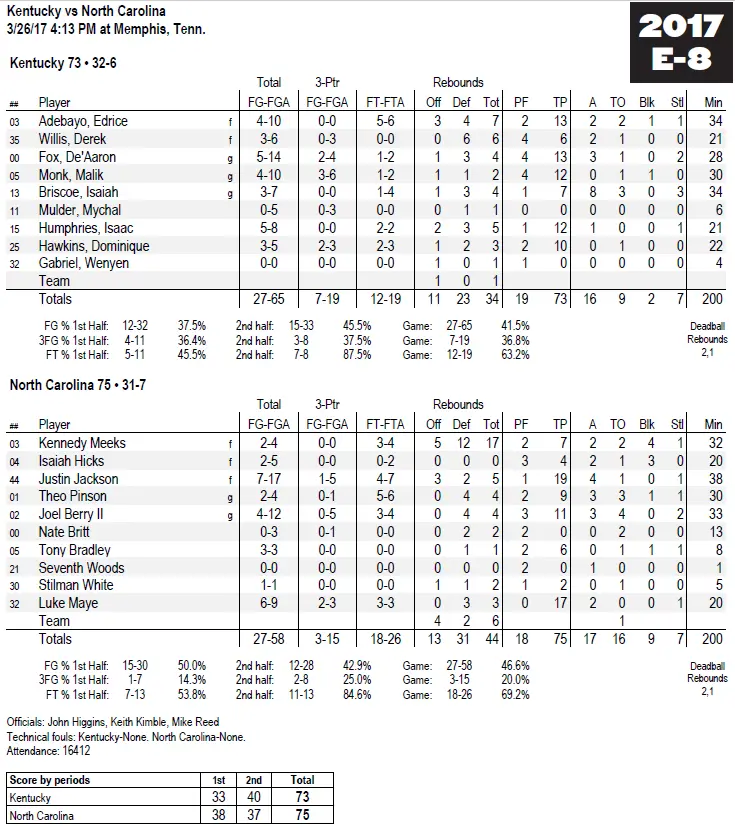
Box score courtesy of Carolina Athletics
No. 2 — No. 5 UNC 79, No. 13 Kentucky 72
College Park, Md | East Regional final |March 19, 1977
This game doesn’t rate this high for the drama, but for the Tar Heels’ resiliency on a big stage.
Star point guard Phil Ford tried to play with a hyperextended right elbow, and center Tommy LaGarde was out with a left knee injury. Forward Walter Davis, with the surgically repaired broken index finger on his shooting hand taped to another finger, led UNC with 21 points.
Ford was the best player in program history running the famed Four Corners, but not with his injury in a game where he scored two points. Coach Dean Smith called on senior John Kuester to be the “chaser” in the Four Corners, and he came through with 19 points and made 13 of 14 free-throw attempts.
Carolina didn’t attempt a field goal in the final 9:35 in the days before the shot clock, but made 33 of 36 free-throw attempts in the game.
Late in the game, Kentucky’s Rick Robey fouled Kuester hard to stop the clock, prompting an upset Smith to have a few words with him. Robey claimed that Smith was profane, but Smith denied that.
“I don’t swear. I was badly misquoted. My mom and dad will be mad if they hear I said those things,” Smith said.
The win advanced UNC to the Final Four in Atlanta’s Omni, where the Heels beat UNLV in the semifinals but lost to Marquette in the championship game.
That win looked more impressive when many of the same Wildcats — including Robey, Jack “Goose” Givens and Kyle Macy — went 30–2 the following season and won the national title, beating Duke 94–88 in the championship game.
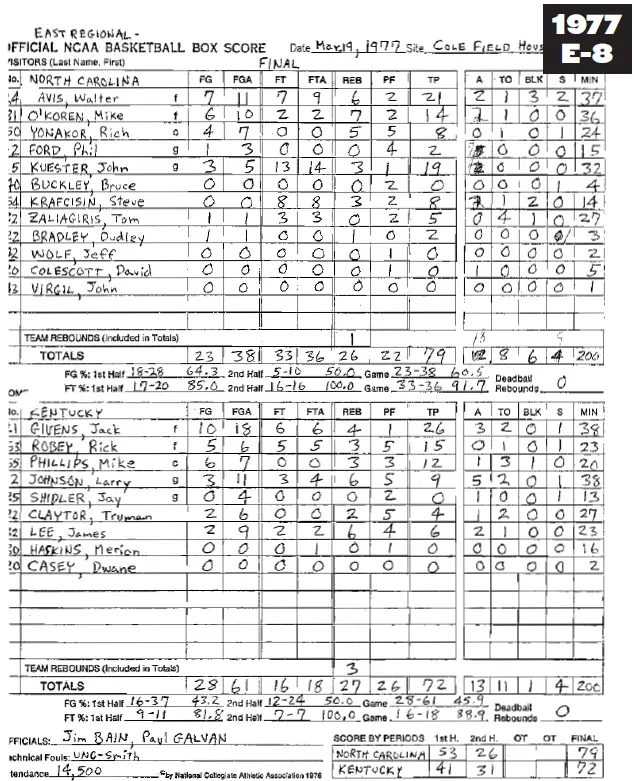
Box score courtesy of Carolina Athletics
No. 3 — No. 1 UNC 82, No. 2 Kentucky 69
East Rutherford, N.J. | Dec. 26, 1981
Coming off a loss to Indiana in the 1981 NCAA final, the Tar Heels — with a freshman named Michael Jordan — were the pick to win it all, and the Tar Heels did that with the memorable Superdome win over Georgetown in the NCAA final.
It may not have been clear how much better Carolina was than the rest of the country until the Tar Heels had little trouble against the No. 2 Wildcats.
With Kentucky center Sam Bowie out after suffering a stress fracture to his left leg, UNC dominated inside, led by James Worthy’s 26 points (with eight rebounds and six assists) and a double-double from Sam Perkins (21 points and 11 rebounds).
UNC only led 38–35 at halftime but took control in the second half.
“We just had to settle down, take it easy,” Perkins said after the game. “Once we got the shots we wanted in the second half, we were fine.”
That Jordan kid? He scored 19 in his sixth college game.
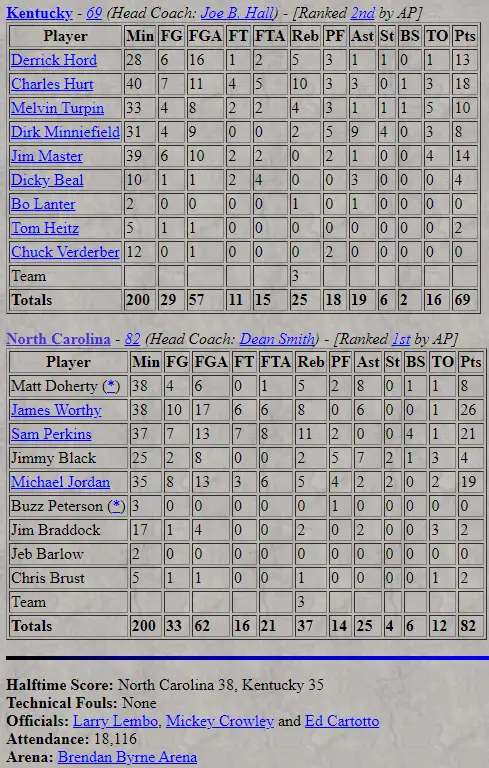
Box score via screenshot from bigbluehistory.net
No. 4 — No. 4 UNC 74, No. 2 Kentucky 61
Birmingham, Ala. | Southeast Regional final | March 25, 1995
Considering an ugly confrontation between Rasheed Wallace and Kentucky’s Andre Riddick, this may have been the most intense game between the programs.
After Wallace swung an elbow into Riddick’s face, Riddick put his hands around Wallace’s throat, and more pushing and shoving ensued.
Carolina won the game behind 18 points each from Jerry Stackhouse and Donald Williams and 12 from Wallace.
UNC lost in a national semifinal at Seattle’s Kingdome to Arkansas 75–68 to end a 28–6 season.
Just like after Kentucky’s 1977 regional final loss to UNC, many of the same Wildcats — including Tony Delk and Mark Pope — came back the next season to win a national championship. Coach Rick Pitino’s team went 34–2, beating Syracuse 76–67 in the NCAA final.
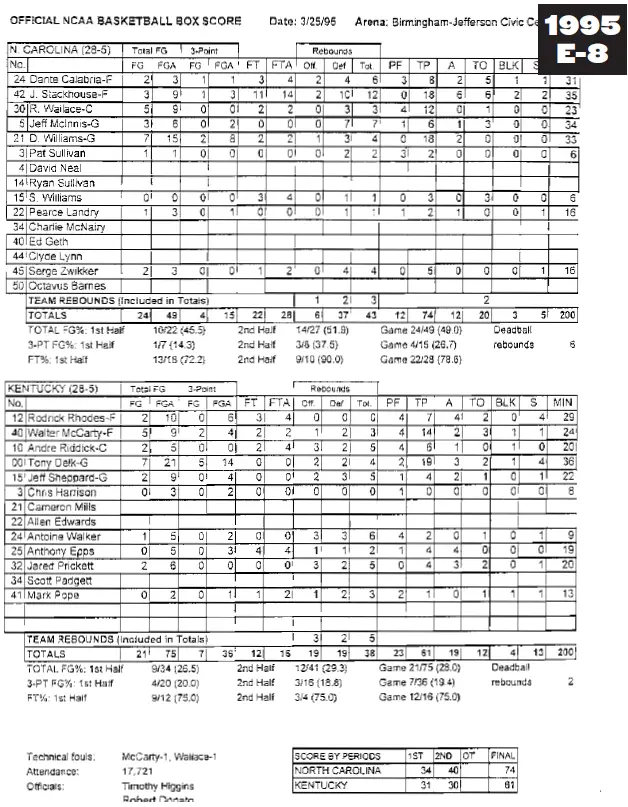
Box score courtesy of Carolina Athletics
No. 5 — No. 6 Kentucky 103, No. 7 Carolina 100
Las Vegas | CBS Sports Classic | Dec. 17, 2016
Carolina couldn’t stop Monk, who scored 47 points, the most any Kentucky player has scored against Carolina. Monk sank eight 3-pointers, including a clutch, tough 3 with 22 seconds left to give Kentucky a one-point lead. Kenny Williams missed a 3-point attempt at the buzzer.
During the first half, a UNC fan yelled at Monk, “You can miss. Please!” He didn’t comply.
“Heck of a college basketball game if you don’t care who won,” Williams said. “But I do care who wins. Malik was off the charts.”
It was an epic shootout, with Jackson scoring 34 points, the most by a Tar Heel against Kentucky, and four 3-pointers. Joel Berry II added 23 points, three 3-pointers and seven assists.

Box score via screenshot from dadgumboxscores.com
No. 6 — UNC 83, No. 10 Kentucky 79
Lexington, Ky. | Dec. 3, 2005
The Tar Heels were coming off a national championship season but lost their top seven scorers from that team. Gone were NCAA tournament MOP center Sean May, point guard Raymond Felton, and forwards Marvin Williams, Jawad Wiliams and Rashad McCants.
That meant Carolina went into the game unranked and as heavy underdogs in Rupp Arena against No. 10 Kentucky, led by Rajon Rondo. The Tar Heels had lost to No. 12 Illinois 68–64 four days earlier in a rematch of the 2005 NCAA championship game.
That was Tyler Hansbrough’s freshman season, and he had six points and 10 rebounds. But it was junior forward Reyshawn Terry who was UNC’s sparkplug with a career-high 25 points, two 3-pointers and seven rebounds. Senior forward David Noel added 15 points, three 3-pointers and nine rebounds.
“We kind of figured everybody would write us off,” Terry said after the game. “We really can’t worry about that. You use that as motivation and try to be better.”
UNC ended an 11-game home Kentucky streak with the first of two wins at Rupp Arena.

Box score via screenshot from bigbluehistory.net
No. 7 — No. 11 Kentucky 76, No. 7 UNC 69
Newark, N.J. | East Regional final | March 27, 2011
Carolina had won 75–73 earlier in the season at the Smith Center (in a game that was a strong candidate for this list) when the Tar Heels were unranked, and the Wildcats were No. 10. But UNC had a tough time overcoming the Wildcats’ hot shooting in the rematch, and Kentucky led 38–30 at halftime.
Junior forward Tyler Zeller led UNC with 21 points and nine rebounds, and freshman forward Harrison Barnes added 18 points.
“No question, I thought we were going to pull it out,” Barnes said after the game. “We’ve been through so many of these situations before. Losing didn’t enter my mind until the final horn sounded.”
Kentucky was off to its first Final Four in 13 years, and Barnes was left surprised and unfulfilled.
“All I know is the last two years I played basketball, it ended with a championship, not a loss,” he said. “I never felt like this before.”
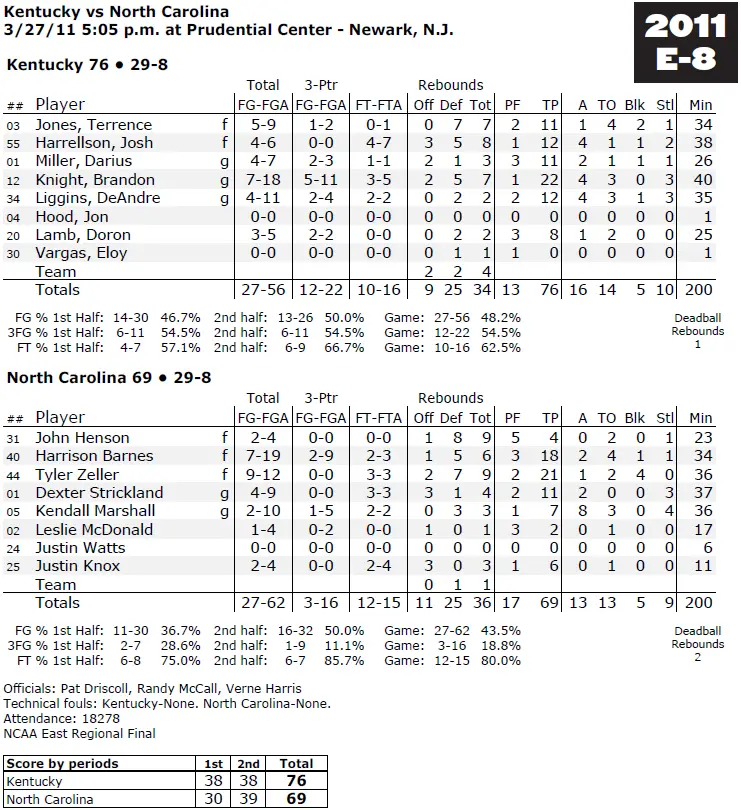
Box score courtesy of Carolina Athletics
No. 8 — UNC 68, Kentucky 66
Lexington, Ky. | Dec. 17, 1962
Smith was coming off an 8–9 debut season as head coach, and took a 3–1 Tar Heels team to tiny old Memorial Coliseum to challenge legendary coach Adolph Rupp in a battle of future Hall of Famers. After opening the season with three wins, the Tar Heels had endured a 90–76 drubbing at Indiana two days earlier.
Both teams were unranked, but the Wildcats went 23–3 the season before and had won the last three meetings with Carolina.
This first matchup under Smith would be different, as Art Chansky wrote in 2005.

In a hint of the Four Corners strategy to come later, Smith spread his players around the court and used passing and cutting until they could get a layup, decades before there was a shot clock.
Larry Brown led four Tar Heels in double figures with 19 points as they pulled out the narrow win after the game was tied at 32 at halftime. Billy Cunningham produced one of his 60 career double-doubles (a school record until Armando Bacot eclipsed it last season) with 13 points and 13 rebounds.
UNC 6–1 guard Yogi Poteet held All-American senior 6–5 Kentucky center Cotton Nash, who later played in the NBA, to 3 of 12 shooting and 12 points, 11.4 points under his average.
Smith was carried off the court in the first of many big victories in his coaching career.
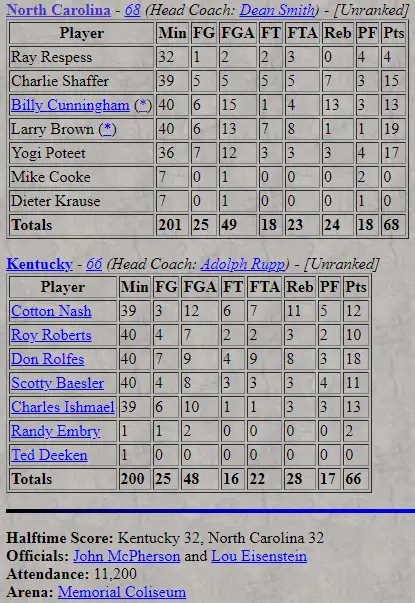
Box score via screenshot from bigbluehistory.net
No. 9 — No. 1 Kentucky 73, No. 5 UNC 72
Lexington, Ky. | Dec. 3, 2011
If not for Carolina losing 90–80 at UNLV as the top-ranked team one week earlier in the Las Vegas Invitational championship, this would have matched the top two ranked teams, which has only happened in that 1981 meeting in the Meadowlands.
P.J. Hairston’s two early 3-pointers gave UNC a 24–18 lead, and Barnes’ jumper made it 34–25 before the Heels took a 43–38 halftime lead. Reggie Bullock’s 3-pointer with 48 seconds left cut a Kentucky lead to one and, after the Wildcats’ Marcus Teague missed the front end of a one-and-one, Carolina had a shot to win it.
Kendall Marshall passed to Tyler Zeller, who had the ball knocked away. John Henson grabbed the ball and quickly shot, but 6–10 freshman Anthony Davis swatted it away, taking advantage of his massive wingspan.
“He came from the other side of the lane; it was a great play by him,” Henson said.
Davis grabbed the rebound to secure Kentucky’s 39th consecutive home victory.
“I just jumped as high as I could with my arm up,” Davis said after the game. “I thought I probably would [block it]. I have long hands.”
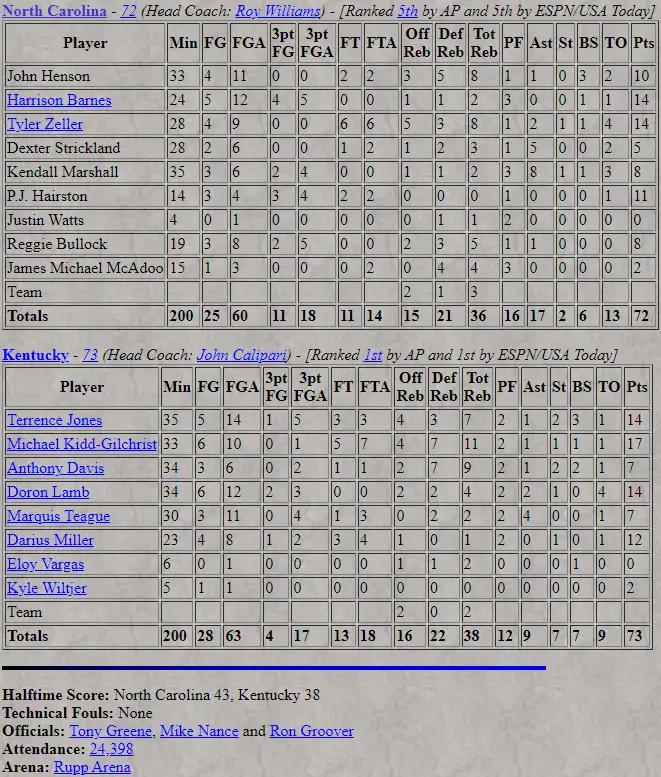
Box score via screenshot from bigbluehistory.net
No. 10 — No. 2 UNC 87, No. 3 Kentucky 77
Lexington, Ky. | Dec. 7, 1968
In the matchup with the second-highest combined ranks in series history, the Tar Heels — coming off a loss to UCLA in the national championship game the season before — won their fourth straight game against the Wildcats and second in a row at Memorial Coliseum.
A UNC team that would go 27–5 and win the ACC regular-season and tournament titles led 43–39 at halftime and coasted to a victory behind Charlie Scott’s 19 points and nine rebounds and one of Rusty Clark’s 43 career double-doubles with 17 points and 16 rebounds.
Mike Casey’s 26 points and Dan Issel’s 19 points and nine rebounds weren’t enough for Kentucky,
Those Tar Heels would win the ACC regular-season and tournament titles and edge Davidson 87–85 in the East Region final to make their third consecutive Final Four, a feat UNC has never repeated.
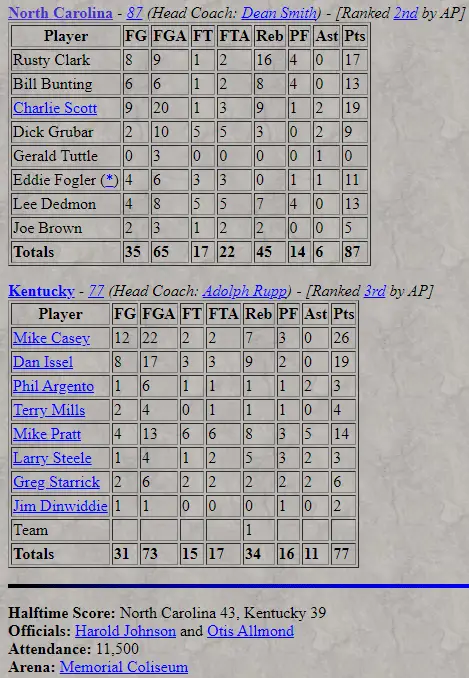
Box score via screenshot from bigbluehistory.net
UNC-Kentucky all-time games

Photo by Nathan Klima, The Daily Tar Heel


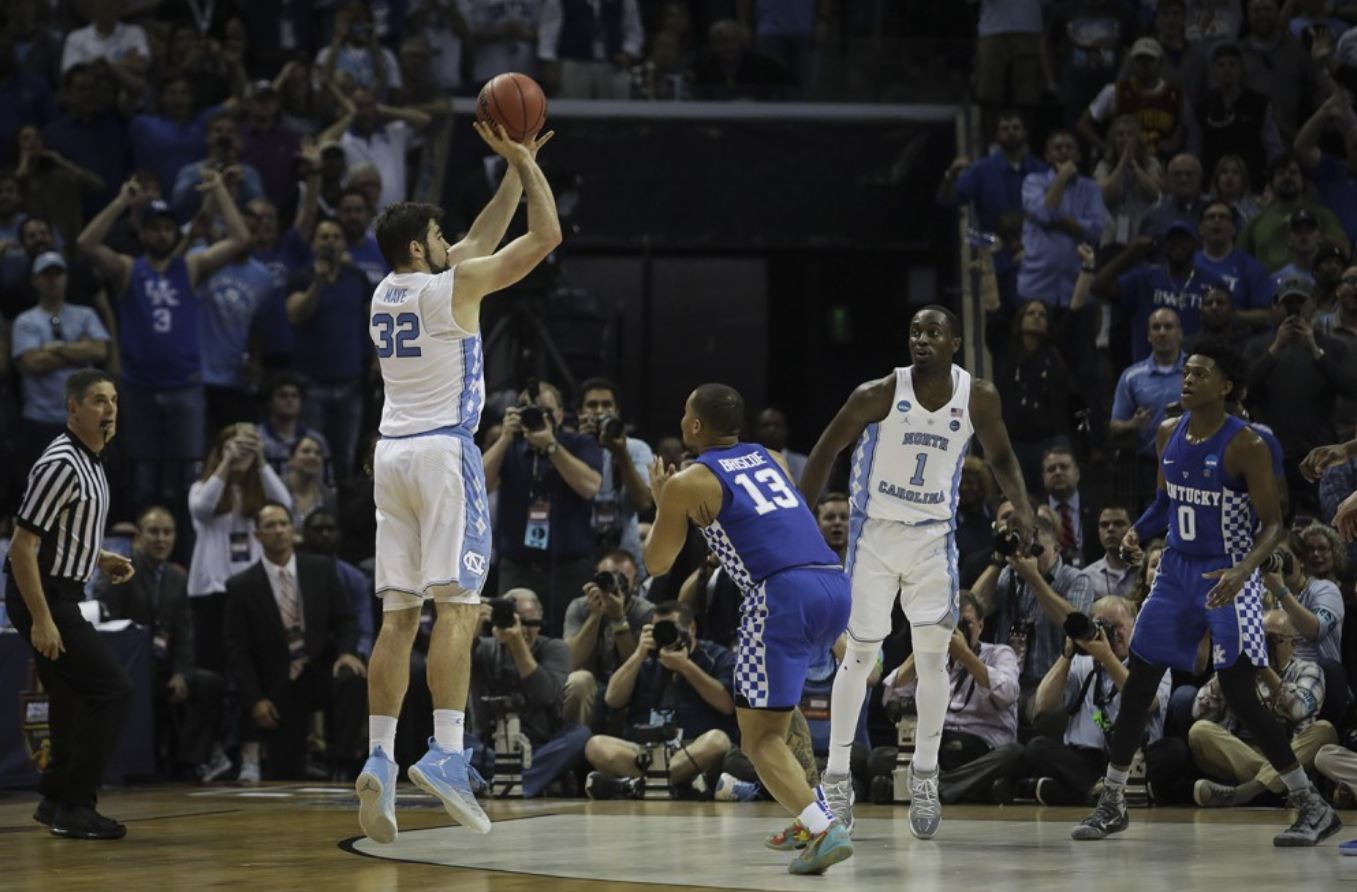
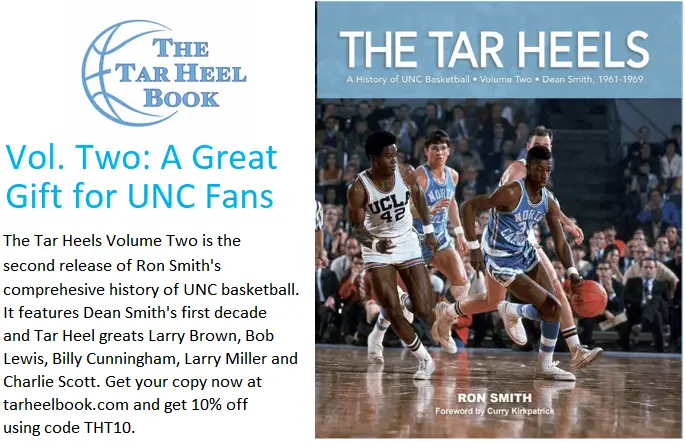
1 Comment